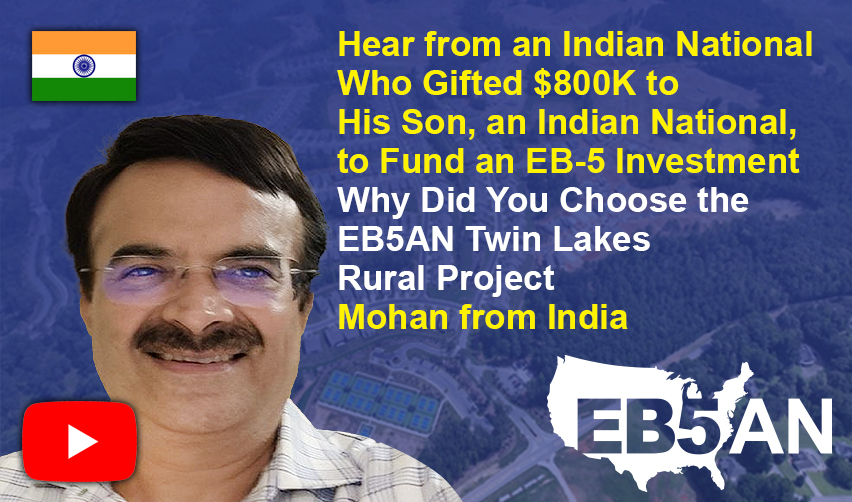I’m Mohan Kumar. In this article, I’d like to share my journey toward a successful EB-5 investment for my son. In this article, I will outline the steps we took, the choices we made, and the insights we gained along the way.
If you are considering an EB-5 investment (for yourself or a family member), I believe my experience can provide valuable insights to help you evaluate opportunities and invest in projects that offer the best chances for immigration success and a positive financial outcome.
My Background
Our EB-5 Investment Journey
- Decision to Pursue EB-5 Investment
- Choosing a Regional Center
- Selecting an Immigration Attorney
- Evaluating Projects
- Investing in Twin Lakes
Securing My Son’s Future Through the EB-5 Program.
My Background
I am currently based in Lagos, Nigeria, where I serve as the director of the Dangote Refinery project. I have been involved in this prestigious project for the last 10 years, with a long career behind me.
My son is studying in the United States and has tried to obtain an H-1B visa through his employer four times without success. Last year, we decided to explore the EB-5 investment route to help him secure a Green Card. This will allow him to live, work, and study in the U.S. with no restrictions.
Our EB-5 Investment Journey
Decision to Pursue EB-5 Investment
After hearing about the EB-5 investment option from my brother in Miami, my son and I decided to pursue this route. We researched the requirements and learned that the minimum investment had been raised from $500,000 to $800,000. We felt confident in our ability to meet this threshold and proceeded with our plan.
Choosing a Regional Center
We conducted a Google search and consulted friends to identify four regional centers that might be suitable for our needs. After further research, we narrowed our list down to three. Our primary objectives were to secure a Green Card for my son and to ensure the safety of our investment. We felt that a good regional center and a solid project were crucial to achieving these goals.
Selecting an Immigration Attorney
We understood the importance of having a skilled attorney to guide us through the process. We spoke with four attorneys before deciding to work with Anahita, an Indian-American attorney with a deep understanding of the EB-5 process and Nigerian income tax laws. Anahita’s knowledge, experience, and commitment to her clients made her an excellent choice for our needs.
She was very thorough in evaluating our source-of-funds documentation. This is likely the most important stage of the application process.
Evaluating Projects
We carefully considered several projects before narrowing our choices down to two: a luxury apartment project in Washington and the Twin Lakes project. After weighing the pros and cons, we decided to invest in Twin Lakes. Factors that influenced our decision included the project’s rural targeted employment area (TEA) location, the strong reputation of the builder (Kolter), and the project’s progress.
Investing in Twin Lakes
When it came to investing in Twin Lakes, we carefully considered several factors that contributed to our decision to choose this project over others. Our focus was on the safety of our investment and its potential for success in creating jobs, meeting EB-5 requirements, and, ultimately, securing a Green Card for my son.
- Builder reputation: A critical aspect of our decision-making process was evaluating the reputation and track record of the builder, Kolter Homes. As one of the top private home builders in the United States, Kolter has an exceptional history of delivering quality projects and ensuring timely loan repayments to investors. Their expertise and strong performance provided us with confidence in the long-term success of the Twin Lakes project.
- Project viability: We analyzed the macroeconomic indicators and market demand for affordable homes in rural areas for retirees. The United States has been experiencing steady demand for such properties, and we believe that Twin Lakes was well-positioned to capitalize on this trend. This positive outlook on the project’s viability made us more comfortable with our investment choice.
- TEA location: Twin Lakes is located in a rural targeted employment area (TEA), which was a significant factor in our decision. Projects in rural TEAs have lower investment thresholds and often provide a faster path to obtaining a Green Card. This advantage was essential to us, as our primary objective was to secure my son’s immigration status in the United States.
- Project progress: At the time of our investment, Twin Lakes had already made significant progress, with over 500 homes sold and all needed jobs created. This demonstrated the project’s ability to meet EB-5 requirements and offered us reassurance that our investment would yield a Green Card. The ongoing success of the project also indicated a lower risk of investment loss or delays in the immigration process.
Securing My Son’s Future Through the EB-5 Program.
In summary, our journey toward a successful EB-5 investment involved careful research, consultation with experts, and thoughtful consideration of various factors.
Ultimately, we chose to invest in the Twin Lakes project through the EB5AN regional center and worked with a skilled immigration attorney to navigate the complex process.
Our experience can serve as a helpful guide for others considering an EB-5 investment, as it demonstrates the importance of evaluating projects and partners carefully to achieve the desired immigration and financial outcomes.








